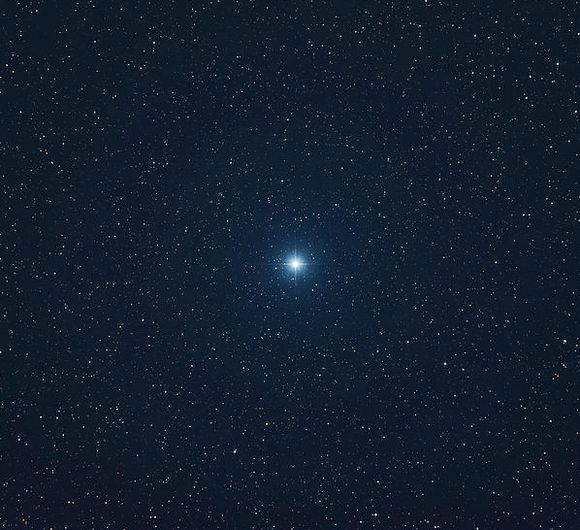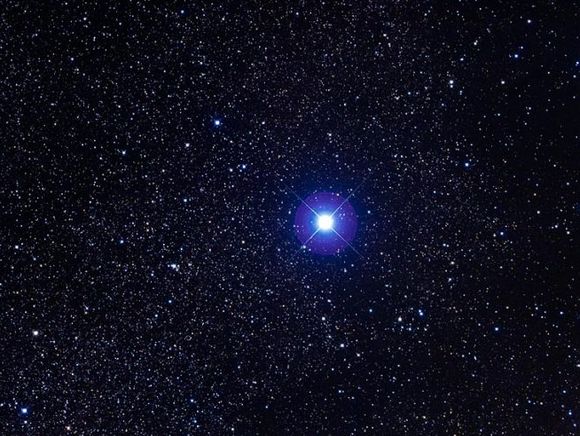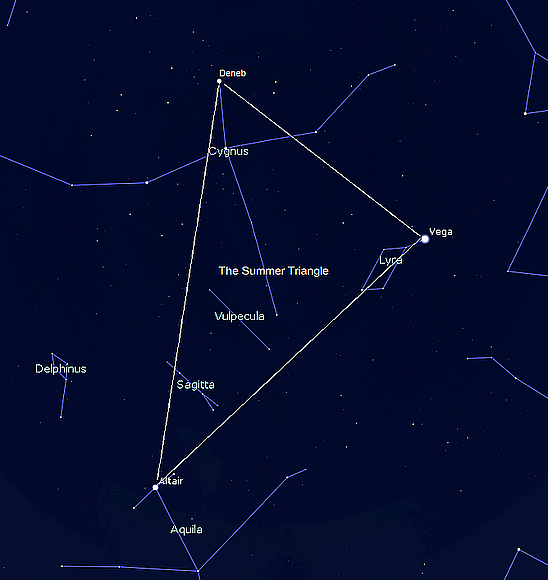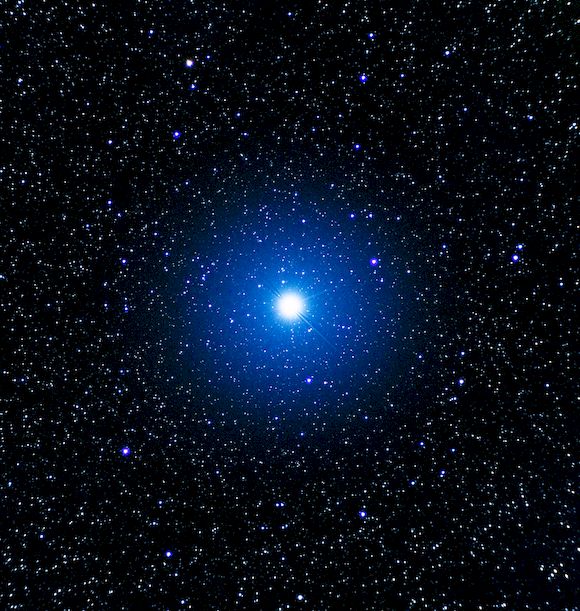High overhead to the south and southeast are the three stars of the ‘summer triangle’. The brightest of these visually, rivalling Arcturus in brilliance and one of the jewels of the night sky, is steely blue Vega, chief star in the small geometric pattern of Lyra the Harp. Vega is the most northern of the summer trio and is visible all year round (circumpolar) from the UK. Vega, a name which is derived from the Arabic for ‘Swooping Eagle’, was often depicted as an eagle bearing a harp in its beak or talons. With an apparent magnitude of 0.03, Vega is the 2nd brightest star visible from the northern hemisphere and 5th brightest star overall. Vega belongs to the spectral class A0V and is 2.1 times the Sun's mass and 58 times more luminous.
The steely-blue lustre of Vega would suggest a star still in the flush of youth, and until quite recently Vega was considered less than 450 million years old, about a tenth of the Sun's age, but because of its higher mass already heading for middle age. However, new estimates indicate that Vega is significantly older than previously thought, because of its fast spin rate, once every 12 hours or so. This has the effect of stirring the star's interior, and forces the surface composition to match the overall composition of the star, causing an over-estimation of Vega’s abundance of heavy metals. This in turn led to an overestimation of the star's mass and an under-estimation of its age. Astronomers studied Vega using the CHARA interferometer, an array of telescopes in California, modelling observations by using new computations of how fast-spinning stars age. These studies indicate Vega is between 625 million and 850 million years old, old enough for planets to have formed and sufficient time for the development of primitive life.
Vega is 2.8 million miles in diameter (4.48 million km) and is surrounded by a circumstellar debris disk, similar to the Kuiper Belt around our Sun and may possibly contain one Jupiter sized planet. Vega was the first star other than the Sun to be photographed in July of 1850, and the first one to have its spectrum recorded and 12,300 years ago was our 'pole star', an honour it will regain in some 13,000 years time!
In a popular Chinese folk tale, one of the few star legends to have passed down from ancient China, Vega is said to represent the weaving girl, granddaughter of the celestial emperor. She made beautiful silks for the gods and goddesses, but she fell in love with a lowly cowherd, represented by the star Altair in Aquila. Following their marriage the couple began to neglect their duties, so to prevent further interruption to their work the emperor separated them, placing them on opposite sides of the Milky Way. The Cowherd was left to bring up their two sons, represented by the stars either side of Altair. Thereafter, the couple were allowed to meet only once a year, on the 7th night of the 7th Moon, when magpies bridged the Milky Way with their wings.
Our next stop, Altair can be located in the ESE in the constellation of Aquila the Eagle and marks the southern vertex of the summer triangle. The name Altair comes from the Arabic for 'flying eagle.' It is associated with the Chinese tale of the weaver girl and goat or cow herder (see Vega) and is known as the 'cow herd' star in China.
At magnitude +0.79 it is one of the brightest stars visible in our summer sky and ranked 12th brightest star in the sky overall. Not suprisingly Altair is one of the 58 stars selected for navigational purposes. Altair has the distinction of being closest of the bright summer luminaries visible from the UK, a mere 16.7 light years away. Its close proximity has allowed its apparent disc size to be directly measured as 3 milli-arcseconds equating to an actual radius almost twice that of our Sun. It has a temperature in the range of 8,200 K and a luminosity ten times greater than our Sun. Of the three stars in the Summer Triangle, Altair is the coolest and least luminous in real terms.
Classed as spectral type A7 and still in the flush of youth, Altair is a star in a spin: an unusually rapid one, rotating on its axis every 8.9 hours. For comparison, the Sun’s rotational period is just over 25 days. This speed causes the equatorial regions of Altair to bulge outwards by over 25% in a rugby ball fashion - though not as pronounced. At a rotational velocity of about 286 km/s, this equates to 71.5 percent of its estimated breakup speed. Altair's proper motion is high, moving relatively fast against the background stars, by as much as one degree within the next 5,000 years. It is the only members of the summer trio to set from our latitude.

Altair - chief star in Aquila the Eagle - southern most of 'summer triangle'
Our final destination is currently located high to the ENE in the constellation of Cygnus. At a mean magnitude of 1.25, Deneb is visually the least conspicuous of the ‘summer triangle’ and is ranked 19th brightest in the sky. Appearances though can be deceptive, its distance and hence luminosity is poorly known, 1700-2600 light years, with an average of 2100 light years. This would equate to a luminosity of 150,000 times with some estimates nearing 200,000 times the Sun's. In short, Deneb is a genuine heavy weight, a blue-white spectral class A2 1a supergiant 25 times the Sun's mass! Deneb's size is estimated to be slightly greater than 200 solar diameters. Its magnitude varies from +1.21 to +1.29. Deneb appears circumpolar from the UK, skirting above the northern horizon when at its lowest point, due north. Due to axial precession, the north celestial pole, which currently lies close to Polaris (Alpha (α) Ursae Minoris), will sit about 7˚ from Deneb in the period around 9800 AD.

Deneb - in Cyguns - the ticking time bomb
Although just a few million years old, Deneb’s high initial mass dictates its rate of evolution, which is extremely rapid, converting energy at a prodigious rate so that even now all of its Hydrogen has been used up. Deneb is a ticking ‘time bomb’ and in little more than 12 million years will evolve into a star almost twice the size of Antares, finally ending its brief life in cataclysmic fashion, as a supernova. On that day our descendents will marvel at this spectacular stellar death, a wonder to all in our galaxy... and beyond.
- Log in to post comments



